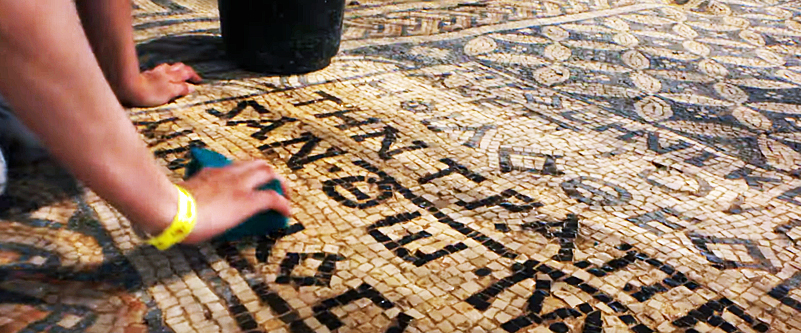Museum of the Bible and the Israel Antiquities Authority (IAA) have announced a new exhibit set to open this fall will feature a decorative mosaic floor from one of the oldest sites of Christian worship. The splendidly decorated hall at Dura-Europus in northern Syria and this building are the earliest known Christian worship sites in the world. “The Megiddo Mosaic: Foundations of Faith” opens to guests on September 15, 2024.
“This is arguably one of the most important archaeological discoveries for understanding the early Christian church,” said Bobby Duke, interim Chief Curator and director of Scholars Initiative at Museum of the Bible. “For example, the mosaic underscores the crucial role of women in the early church by the fact that 5 women are mentioned in it by name. Truly, the mosaic presents a wealth of new data for church historians, like the Dead Sea Scrolls did for Bible scholars.”
The Megiddo Mosaic — which dates to the third century — formed part of the floor of the oldest site of Christian worship ever to be discovered. The mosaic, and the building containing it, were uncovered 20 years ago by Dr. Yotam Tepper from the Israel Antiquities Authority. It was discovered during a pre-construction archaeological dig in the Megiddo prison in Israel, as it was planned to build a new wing in the prison. Eventually, prisoners worked alongside the archaeologists to uncover the rare discovery. The mosaic was preserved by the IAA and was covered, until today.
Carlos Campo, chief executive officer at Museum of the Bible, remarked, “We are thrilled to serve as the inaugural site to premiere this groundbreaking piece of history and are grateful to the Israel Antiquities Authority for its trusted partnership as we’ve worked together to present the mosaic to the world.”
According to Alegre Savariego, curator of the exhibition on behalf of the IAA, “The mosaic presents groundbreaking physical evidence of the practices and beliefs of early Christians, including the first archaeological instance of the phrase, ‘God Jesus Christ.’ Also featured on the mosaic are one of the earliest examples of a fish being used as a Christian symbol and the names of several of the church’s patrons — a Roman centurion, an artist, and five women.”

The conservation of the mosaic was done by the Conservation Department of the Israel Antiquities Authority. The mosaic was cleaned, its edges stabilized, and lacunae, or empty spaces, were filled in with mortar. Then, loose tesserae, the stone cubes that make up the mosaic, were grouted and re-laid on new supports.
After in situ conservation was complete, archaeologists reburied the mosaic while the IAA conducted research. When the IAA decided to move the mosaic for exhibition in 2024, archaeologists and conservators worked together to uncover the mosaic. After the meticulous cleaning and conservation process, it was divided into sections that could be safely shipped while preserving its integrity without distortion.
According to Eli Escusido, director of the IAA, “The Israel Antiquities Authority is delighted to finally present the important Megiddo Mosaic to the world. The Megiddo Mosaic will be presented in its first venue at the Museum of the Bible for 9 months. After display in some additional venues, it will return to Israel and is planned to be presented in a permanent exhibition at the exact site where it was discovered. The ancient site will be developed and presented for the benefit of visitors and tourists.”
The mosaic will be accompanied by artifacts discovered during its excavation, which offer a glimpse into daily life in the Roman Sixth Legion Ferrata. These items include roof tiles, an inscribed bread stamp, a bronze statuette of the Roman god of home Lar, engraved Carnelian intaglios, fragments of mortarium pottery with the Greek inscription “Peace and Luck,” and coins.
More information on Museum of the Bible is available here.
Museum of the Bible is an innovative, global, educational institution whose purpose is to invite all people to engage with the transformative power of the Bible.
